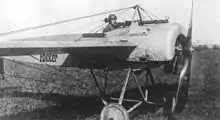Engine turning
Engine turning may refer to either Guilloché engraving, or the different process of Perlée (also known as spotting, jewelling, perlage) which is a fine geometric pattern of overlapping circles abraded onto the surface. Aluminium is often the metal chosen to decorate with jewelling, but any appropriate surface can be finely machined to produce intricate repetitive patterns that offer reflective interest and fine detail.[1][2][3]




Uses
Aircraft
Perlée-style engine turning was used on the sheet metal panels of the engine cowling (nose) of Charles Lindbergh's aircraft, the Spirit of St. Louis.
The sheet metal parts of the World War I Fokker Eindecker fighters aircraft series, especially around the engine cowl and associated sheet metal, are noted for having a "dragged" form of engine turning entirely covering them. The tool creating the "swirls" was repeatedly moved along a short, irregular path each time while pressed against the metal, to create the intricate appearance that was characteristic of the aircraft's sheet-metal parts. It is partly surmised to have been a mechanical method to "clad" a duralumin-alloy sheet-metal panel with a layer of pure aluminum, for corrosion protection.
Automobiles
In the 1920s and 1930s, automobile parts such as valve covers, which are right on top of the engine, were also decorated with perlage engine turning. Similarly, dashboards or the instrument panel of the same were often perlaged. Customizers also would similarly decorate their vehicles with perlage engine-turned panels.
Documents
Engravings produced by engine turning are often incorporated into the design of bank notes, and other high-value documents, to make counterfeiting difficult. The resulting graphics are called guillochés.
Firearms
Perlage Engine turning is also used on various firearm components to prevent corrosion by holding traces of oil and lubricants on the surface, in turn to a polished surface resulting in a smooth operation.
See also
References
- "Engine Turning vs. Spotting". Circuitous Root.
- "Eamonn Keogh's Engine Turning Page". Computer Science and Engineering - University of California, Riverside.
- Warfield, Bob (18 July 2017). "Guilloche, Rose Engines, Jeweling, & Engine Turning for Artistic Machining". CNCCookbook.
External links
- Engine Turning on YouTube by The Unemployed Prop Guy